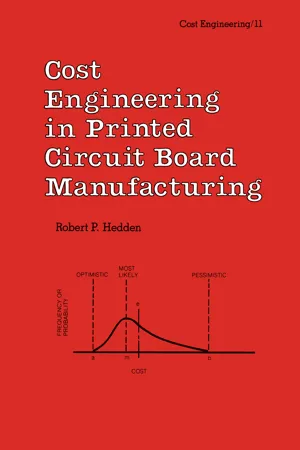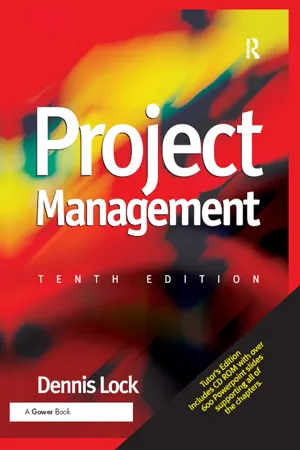Cost Estimation
Cost estimation is the process of predicting the expenses associated with a project or product. It involves analyzing various factors such as materials, labor, and overhead costs to arrive at an accurate budget. This helps in planning and decision-making, ensuring that resources are allocated efficiently and projects are completed within financial constraints.
7 Key excerpts on "Cost Estimation"
- Triant G. Flouris, Dennis Lock(Authors)
- 2016(Publication Date)
- Routledge(Publisher)
...5 Estimating the Project Costs Cost estimates are necessary for all projects, and cost re-estimates are often needed at times throughout the project life cycle. Without a cost estimate it would be impossible to carry out financial appraisal or prepare a business plan for a new project. Project management requires cost estimates to establish detailed budgets, help control spending, assess manpower requirements and perform many other management procedures. A company’s sales executives, sometimes in committee with their more senior company management, must rely on cost estimates when deciding the price to be offered in proposals to external customers for aviation projects. INTRODUCTION TO COST ESTIMATING There are several reasons why cost estimating is not a popular pastime with technical people. Those asked to put aside more creative work whilst they give thought to the possible costs of future projects will regard the exercise as an unwelcome distraction. Yet they know just how difficult cost estimating can be. Get it wrong, and their mistakes or bad judgments in this important function will come home to haunt them in the future. Cost estimating is an onerous task but it carries great responsibility. Some companies employ cost or estimating engineers whose only role in life is to live with cost estimating and cost reviews. Other companies assign the cost estimating task to their line managers. However, whatever the original source of cost estimates it is always wise and recommended that experienced line managers should be involved in the process. These managers should at least be asked to review and approve the cost estimates that will ultimately become their own committed working budgets. A cost estimate for a large aviation project will collect a great amount of data. This brings us to another aspect of cost estimating, which is that it must be approached with great formality...
- eBook - ePub
- Dennis Lock(Author)
- 2018(Publication Date)
- Routledge(Publisher)
...5 Cost estimating An accurate estimate of project costs is necessary for subsequent management decisions and control. The most obvious reason for producing cost estimates is to assist in pricing decisions, but estimates are usually needed for all commercial projects, including in-house projects and those sold without fixed prices. Timescale planning, pre-allocation of project resources, the establishment of budgets for funding, manpower and cost control, and the measurement of achievement against expected performance all demand sound estimates. Cost format The estimator should have a working knowledge of the way in which the organization’s cost accounting system operates. Figure 5.1 shows a typical distribution of the costs for an industrial project. The bottom item shows direct labour costs, which are all the man-hours that can be directly attributed to the project multiplied by their appropriate cost rates. In some companies, a labour burden is added, pro rata, to these costs to cover such items as National Insurance contributions and non-salary benefits. Figure 5.1 A typical cost structure Other costs in the illustration are classed as either direct or indirect, the distinction again being whether or not these costs can be directly attributed to the project. The rate at which direct costs are incurred varies with the rate of working on the project, and most direct costs are therefore classed not only as direct costs but also as variable costs. Indirect costs include all general expenses of the organization, such as management and general administration, accommodation, heat, light, business rates and so on...
- eBook - ePub
- Ray R. Venkataraman, Jeffrey K. Pinto(Authors)
- 2011(Publication Date)
- Wiley(Publisher)
...Perhaps out of urban development, some positive results will emerge. The same cannot be said for the Millennium Dome, a mixture of bad cost control and appallingly optimistic projections. 1 The Millennium Dome’s lesson is that all projects, regardless of size, require meticulous planning and a thorough analysis of expected project costs, along with the associated value delivered. To that end, this chapter focuses on the issues and methods associated with estimating the costs of projects. 3.1 Importance of Cost Estimation A recent survey conducted on information technology (IT) projects revealed that more than 83 percent fail to meet their economic goals. Two of the major culprits cited for IT project problems are erroneous cost estimates and overlooking key project costs. 2 Estimating project costs are important for a number of reasons: They provide a standard against which actual expenditures incurred during the course of a project can be compared, and serve as the basis for cost control. They are the chief means for assessing project feasibility. A comparison of the cost estimates with the estimates of revenues will enable the project organization to determine if the project is worthwhile to undertake. Along with project returns, they facilitate decisions relating to project financing and funding. They provide the mechanism for managing cash flow during the course of the project. They give the project manager a framework for allocating scarce resources as the project progresses. They provide the mechanism for revising project activity duration. To a great extent, project success hinges on accurate Cost Estimation. While a number of factors can contribute to cost overruns, one of the main culprits is project acceleration. As we will show in Chapter 4, this is because the relationship between cost and time is not always linear...
- eBook - ePub
- Dennis Lock(Author)
- 2017(Publication Date)
- Routledge(Publisher)
...Far-fetched? This procedure has been proved in practice. ESTIMATES FOR MATERIAL AND EQUIPMENT COSTS Responsibility for estimating the costs of materials and equipment usually lies in two areas. The engineers or designers must specify what materials and equipment will have to be bought and the purchasing department will be expected to find out how much these will cost and how long they will take to obtain. If the purchasing organization is not allowed to partake in preparing the detailed estimates, a danger exists that when the time eventually comes to order the goods these will be obtained from the wrong suppliers at the wrong prices. It is far better if the big items of expense can be priced by getting quotations from the suppliers as early as possible. The buyer can keep all such quotations in readiness for the time when the project becomes live. If the purchasing department is to be held down to a materials budget, then it is only reasonable that its buyers should play the leading role in obtaining the cost estimates for materials and equipment. Expenditure on materials and bought-out services can exceed half the total cost of a project. The proportion can be as high as 80 per cent. Unfortunately the purchasing function is not always given the recognition that it deserves in project management. Materials need two types of estimate. These are: 1. The total expected cost, including all delivery and other charges. 2. The lead time, which is the elapsed time between placing the purchase order and receiving the goods at the point of use. It might also be necessary to make estimates of other factors for operational purposes. For example the volume or weight of materials might be needed in order to arrange for storage, handling or onward transport. If no detailed design has been carried out, no parts lists, bills of materials or other schedules will exist. In that case the engineers should be asked to prepare a provisional list of materials for each task...
- R. P. Hedden(Author)
- 2020(Publication Date)
- CRC Press(Publisher)
...7 Estimating Engineering and Other Expenses The cost of engineering support for the printed circuit board and electronics industry has been mentioned as significantly larger than in most other industries. It has been said that the three major elements of cost in most manufacturing processes are labor, overhead, and material. Typically, engineering is included in overhead, but in the electronics industry it is usually separately estimated, tracked, and managed as the fourth element of cost because of its magnitude. Engineering expense includes the effort to develop and then support manufacturing processes through the life of the product. Although the cost of designing and developing new products is an engineering expense, it is excluded from this discussion and is considered part of research and development. However, the principles discussed here may also be applied to research and development expense estimating. The various activities included in engineering expense are the design and debugging of tooling and equipment for the manufacturing processes, scaleup activities for volume increases, writing process specifications, and so on. Engineering is also responsible for estimating the cost to design and build tooling and equipment and for estimating the costs of materials used in the product and the processes required to build the product. Figure 1.2 illustrated a form for the recording of manufacturing operation information. On that form is space for the inclusion of design, building and debugging cost, and installation cost for equipment associated with the operation. Estimating these costs, along with the related process design cost and material costs, is the subject of this chapter. In a new technology estimate it is usually necessary to estimate overhead rates. A major cost element in overhead is equipment depreciation. The capitalized cost, which is depreciated, generally consists of the design, building, and debugging cost...
- eBook - ePub
- Dennis Lock(Author)
- 2020(Publication Date)
- Routledge(Publisher)
...If an engineer or other responsible person from the project team collects the estimates, he/she can often supply this help by explaining the design specification in terms that non-project people can understand. Similarities with past jobs can be suggested and any artists’ impressions or other sketches that might be available can be shown and described. Estimates for Materials and Equipment Costs Materials always need two types of estimate. For each purchase these are as follows: 1. the total expected cost, including all charges and taxes payable in transporting the materials to the project location; 2. the total lead time, which is the time expected to elapse between issuing the purchase order and receiving the consignment (failure to get materials on time is a common cause of delays and late project completion). It might also be necessary to make estimates of other factors for operational purposes; for example the volume or weight of materials (information needed for storage and handling). If detailed design has yet to be carried out, no parts lists, bills of materials or other schedules will exist from which to control the estimating process. Therefore the next best approach is to ask the engineers to prepare provisional bills of materials or purchasing schedules. This may be impossible to carry out in any detail, but the problem is not as difficult as it sounds. In most work the engineers have a very good idea of the more significant and most expensive items that will have to be purchased. There might be special components, instruments, control gear, bearings, heavy weldments or castings, all depending of course on the type of project. Items such as these can account for a high proportion of the costs and are frequently those which take the longest time to obtain...
- eBook - ePub
- Ovidiu Cretu, Robert B. Stewart, Terry Berends(Authors)
- 2011(Publication Date)
- RSMeans(Publisher)
...The costs assumed for contractor overhead and profit as well as for subcontractor work should also be clearly documented. It is important to remember that these decisions may not reflect the decisions of the individual contractors that will bid the job, thus introducing elements of risk into the estimate. Final Estimate or Bidding/Letting Phase The engineer's estimate is prepared for the final contract review in preparation for advertisement or letting and is used to obligate construction funds and to evaluate contractors' bids. Historical bid-based, cost-based, and risk-based are some of the techniques used while preparing final estimates. The project has matured to a point where design engineers and estimators are able to specify all items of work that will be required for the project and can accurately estimate quantities and unit prices. This level of project estimate has the advantage of detailed understanding of project scope and conditions. If the estimators are from outside the project team, they should take special care to understand the details of the project, including performing a detailed review of the plans and specifications. Clearly document the development of and adjustments to line item quantities and prices. This is critical for both the review of the estimate and the review of bids prior to award. This data should be clearly defined and identified in the estimate file. Historical bid-based methodologies should be used for most items of work where historical data is available. Cost-based estimating methodologies can be used for those items with little or no bid history, or to check major items of work that significantly impact on the total project cost. Miscellaneous item allowances should not be included in an estimate at this level...






